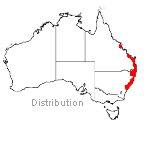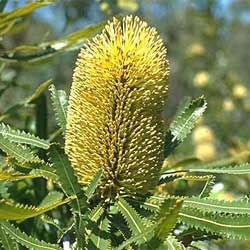
Banksia Aemula
Common name: Wallum Banksia
I grow best: Part shade/full sun
• Height up to 8m
• Sandy soil
• Flowers – March – June
• Attracts – Bees, birds, butterflies, other insects
• Cultural uses
• Eastern Suburb Banksia Scrub
Looks like: Banksias range from low-growing shrubs to trees.
Banksia aemula grows as a robust tree to about 8m of height, or can remain as a chunky, spreading shrub that grows in an irregular manner, often giving it the appearance of being sculptured. It has a ‘heavy’ appearance, the trunk appearing quite large relative to the tree. The reddish coloured bark is corky and attractive, similar to Banksia serrata. It would be useful as a screening plant in the garden or make an interesting tree feature. The leaves are another appealing feature of the tree. The margins are serrated, less coarsely than those of Banksia serrata. The leaves occur alternately along the stem and are narrow-obovate to oblong in shape. They can vary from 3-20cm long and between 5-30mm wide, distinguishing it from the wider-leaved Banksia serrata.
Flowering of Banksia aemula generally occurs in autumn and early winter (March to June). However, it can flower sporadically throughout the year. The buds start out green with inflorescences turning a vivid pale yellow and the styles changing colour with maturity to brown then grey. The old flowers remain persistent and form intriguing fruit with large protruding seed follicles – the basic design for May Gibbs’ literature villains, the ‘Big Bad Banksia Men’. The cylindrical flower spikes are about 85mm wide by 100-150mm long. The flowers of Banksia aemula are valuable in the garden for attracting native birds. The flowers are more exposed and brighter than those on Banksia serrata. Australia’s traditional owners often used Banksia aemula flowers for a source of nectar.
Habitat & Propagation: Banksia aemula can be found in Queensland and New South Wales, from Bundaberg to Sydney, in coastal heath on sandy soils. Banksias can be grown from seed collected from the fruit. The fruit can be opened when placed in a hot oven for 5-10 minutes; longer times can cause the seeds to be scorched as heat enters the opening follicles. Burning the fruit to obtain seeds is also effective as the follicles open faster and thus the seeds are subjected to heat for a shorter time.
Well drained soils are necessary for the cultivation of Banksia aemula to replicate its ‘Wallum’ habitat. All heathland species prefer full sun throughout the day, and if shaded for part of the day will be less robust and produce fewer flowers. Plants like Banksia aemula with a lignotuber or fire tolerant stems tend to be much longer lived than those without them. They can also be heavily pruned and sculptured. Banksias generally remain free of disease; especially if they are grown in full sun with well drained soil.
Banksia aemula is a versatile garden tree or shrub, that is tolerant to frost and heavily salt laden winds. Despite its brighter flowers and flexible garden nature it is less widely available in nurseries than Banksia serrata.
Seeds should be sown in a very freely draining seed-raising mix which should not be allowed to dry out. As Banksia seedlings are prone to fungal attack, it is better to sterilise the seed-raising mix before planting. If this is not practical, very clean ingredients should be used. Seedlings should be transplanted into small pots as soon as the first true leaves appear. A potting mix made from equal parts of river sand, loam and leaf mould (or peat moss) is generally suitable.
| Family | Proteaceae |
| Plant Type | Small shrub, Large shrub |
| Width | 2.5 |
| Flowering Time | Autumn |
| Soil Type | Sandy, Sandy loam |
| Climate Zone | Sub-tropical, Warm temperate, Cool temperate, Mediterranean, Semi-arid |
| Growth Habit | Evergreen |
| Soil Moisture | Well-drained |
| Special Uses | Cut flower |
| Height | 5 |
| Flower Colour | Yellow, Green |
| pH Level | Acid, Neutral, Alkaline |
| Plant Environment | Low maintenance garden, Poolside, Coastal garden, Drought resistant |
| Light | Sunny |
| Frost Tolerance | Tolerates light frost |
| Attracts Wildlife | Bees, Nectar eating birds, Butterflies, Other insects |
Distribution:


